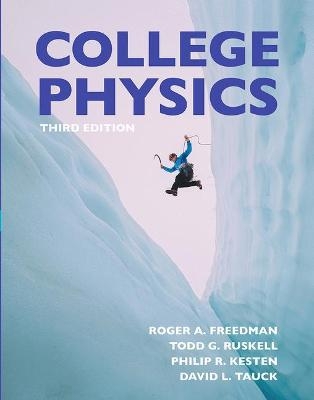
College Physics
W.H.Freeman & Co Ltd (Verlag)
978-1-319-38345-9 (ISBN)
Transform every student’s potential with Freedman’s College Physics and Achieve
Now available for the first time with Macmillan’s new online learning tool Achieve, Freedman’s College Physics makes it easy for instructors to support every student by using best teaching practices in their algebra-based physics courses. With resources for before, during, and after class, students of all backgrounds are engaged and supported at every step of the learning process. The text further supports student comprehension with its hallmark Set Up, Solve, Reflect problem-solving approach to help students understand and visualize problems. Perfect for students of all backgrounds, the text contains call-outs to additional math review and relevant applications of physics, including those from biology.
In this edition, the end-of-chapter questions have been thoroughly updated for clarity and quality and over 80% are now available for assigning in Achieve, while still featuring detailed and targeted feedback, solutions, and hints for every question.
Dr. Roger A. Freedman is a Lecturer in Physics at the University of California, Santa Barbara. He was an undergraduate at the University of California campuses in San Diego and Los Angeles, and did his doctoral research in theoretical nuclear physics at Stanford University. He came to UCSB in 1981 after three years of teaching and doing research at the University of Washington. At UCSB, Dr. Freedman has taught in both the Department of Physics and the College of Creative Studies, a branch of the university intended for highly gifted and motivated undergraduates. In recent years, he has helped to develop computer-based tools for learning introductory physics and astronomy and has been a pioneer in the use of classroom response systems and the “flipped” classroom model at UCSB. Roger holds a commercial pilot’s license and was an early organizer of the San Diego Comic-Con, now the world’s largest popular culture convention. As a Teaching Professor of Physics at the Colorado School of Mines, Todd G. Ruskell focuses on teaching at the introductory level, and continually develops more effective ways to help students learn. One method used in large enrollment introductory courses is Studio Physics. This collaborative, hands-on environment helps students develop better intuition about, and conceptual models of, physical phenomena through an active learning approach. Dr. Ruskell brings his experience in improving students’ conceptual understanding to the text, as well as a strong liberal arts perspective. Dr. Ruskell’s love of physics began with a B.A. in physics from Lawrence University in Appleton, Wisconsin. He went on to receive an M.S. and Ph.D. in optical sciences from the University of Arizona. He has received awards for teaching excellence, including Colorado School of Mines’ Alumni Teaching Award. Dr. Ruskell currently serves on the physics panel and advisory board for the NANSLO (North American Network of Science Labs Online) project. Dr. Philip Kesten, Associate Professor of Physics and Associate Provost for Residential Learning Communities at Santa Clara University, holds a B.S. in physics from the Massachusetts Institute of Technology and received his Ph.D. in high energy particle physics from the University of Michigan. Since joining the Santa Clara faculty in 1990, Dr. Kesten has also served as Chair of Physics, Faculty Director of the ATOM and da Vinci Residential Learning Communities, and Director of the Ricard Memorial Observatory. He has received awards for teaching excellence and curriculum innovation, was Santa Clara's Faculty Development Professor for 2004-2005, and was named the California Professor of the Year in 2005 by the Carnegie Foundation for the Advancement of Education. Dr. Kesten is co-founder of Docutek, (A SirsiDynix Company), an Internet software company, and has served as the Senior Editor for Modern Dad, a newsstand magazine. Dr. David Tauck, Associate Professor of Biology, holds both a B.A. in biology and an M.A. in Spanish from Middlebury College. He earned his Ph.D. in physiology at Duke University and completed postdoctoral fellowships at Stanford University and Harvard University in anesthesia and neuroscience, respectively. Since joining the Santa Clara University faculty in 1987, he has served as Chair of the Biology Department, the College Committee on Rank and Tenure, and the Institutional Animal Care and Use Committee; he has also served as president of the local chapter of Phi Beta Kappa. Dr. Tauck currently serves as the Faculty Director in Residence of the da Vinci Residential Learning Community.
1. Introduction to Physics
2. Motion in One Dimension
3. Motion in Two or Three Dimensions
4. Forces and Motion I: Newton’s Laws
5. Forces and Motion II: Applications
6. Work and Energy
7. Gravitation
8. Momentum, Collisions, and Center of Mass
9. Rotational Motion
10. Elastic Properties of Matter: Stress and Strain
11. Fluids
12. Oscillations
13. Waves
14. Thermodynamics I: Temperature and Heat
15. Thermodynamics II: Laws of Thermodynamics
16. Electrostatics I: Electric Charge, Forces, and Fields
17. Electrostatics II: Electric Potential Energy and Electric Potential
18. DC Circuits: Electric Charges in Motion
19. Magnetism: Forces and Fields
20. Electromagnetic Induction
21. Alternating-Current Circuits
22. Electromagnetic Waves
23. Physical Optics: Wave Properties of Light
24. Geometrical Optics: Ray Properties of Light
25. Relativity
26. Quantum Physics and Atomic Structure
27. Nuclear Physics
28. Particle Physics and Beyond
| Erscheinungsdatum | 25.03.2021 |
|---|---|
| Zusatzinfo | Approx. 1360 p. |
| Sprache | englisch |
| Maße | 155 x 235 mm |
| Themenwelt | Naturwissenschaften ► Physik / Astronomie ► Allgemeines / Lexika |
| ISBN-10 | 1-319-38345-9 / 1319383459 |
| ISBN-13 | 978-1-319-38345-9 / 9781319383459 |
| Zustand | Neuware |
| Haben Sie eine Frage zum Produkt? |
aus dem Bereich


